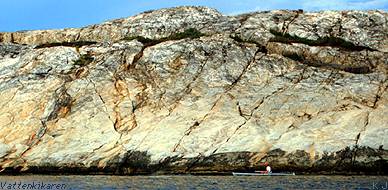 |
|
Bare belt
The Swedish coastline is a little unusual because
it is the weather that effects the water level more than the tides. On a
great many coasts, for example Icelands, Norways and Britians, the tidal
differences are much greater, 1 m or more - and is therefore of greater
importance than variations in wind and air pressure. This is significant
for beach living organisms as tidal variations are much more regular than
variations in weather.
When the wind is calm and there is a high pressure over the
Swedish coast, many organisms can be left stranded on the beach over a period
of several days without being moistened by the tide, where as on windy days
with low pressure, they can be kept wet several days in a row. This is presumably
why Swedish coastal areas have a pronounced bare belt along the cliffs,
which are otherwise normally uncommon globally. Where tidal variations dominate,
lengthy and unpredictable periods of low or high water are uncommon and
normally only effect a narrow zone of the beach.

| Between the zones of black
cyanobacteria and the grey lichens higher up - on these wave
exposed cliffs - exists a wide bare belt. |
 |
Page 24 of
52 |
 |
|



